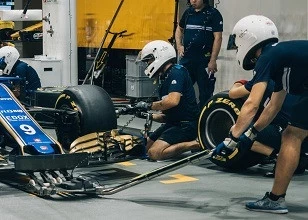Future Proofing Business and Avoiding the Unmanageable
Add bookmarkLeading companies increasingly understand how man-made impacts present new business risks and are starting to adapt business practices, writes Dax Lovegrove, Head of Business and Industry at WWF. But, he says, many companies aren't doing enough.
WWF’s Living Planet Report is the latest health check on the natural world. It shows we are currently using 50% more natural resources than the earth can sustain - the equivalent resources of 1.5 planets to support our activities. A continuation of current trends on a global scale would mean that by 2030 we’d need the equivalent of two planets’ productive capacity to meet our annual demands.
On the water front, the International Food Policy Research Institute (IFPRI) anticipates future demand for water will outstrip our capacity to provide it if current water withdrawal practices continue. Demand may increase by as much as 30% by 2030 according to the IFPRI. This will be particularly impactful on food production, since agriculture accounts for about 70% of human water use across the globe.
These problems are exacerbated by climate change with extreme weather events becoming more intense and more frequent and this brings all kinds of added threats to all industries including the food sector. For example, wheat production in 2010 across Europe, Australia and Russia was hit hard by unusually dry weather. Increased volatility in weather patterns of this nature is undoubtedly a contributing factor to record high food prices, which the Food and Agriculture Organisation (FAO) says are likely to go on rising.
It is therefore in the interests of business to adapt to the climate change that is already in the system while also working to prevent future runaway climate change. As others put it, we need ‘to manage the unavoidable and avoid the unmanageable’. WWF’s ‘Plugging the Gap’ report says the world is on-course to emit as much as 53 gigatonnes of CO2 (or the equivalent in other greenhouse gases) per year by 2020 based on the pledges by countries during and since the climate talks in Copenhagen. However, scientists recommend a safe upper limit is 40 gigatonnes per year.
This is the big picture of today, which gives us an idea of what we’re up against.
Leaders and Laggards
Leading companies increasingly understand how these man-made impacts present new business risks and are starting to adapt business practices. However, the vast majority of businesses are failing to respond to these threats. A study out earlier this year from MIT SMR and the Boston Consulting Group discusses "embracers"- those that place sustainability high on their agenda - and "cautious adopters" and the substantial gap between the two.
The sustainability plans from Unilever and M&S discuss the companies’ attention given the managing the major and broad range of impacts – the carbon, water and ecological footprints - from their supply chains and from the customer use of products. This contrasts with many other businesses’ preoccupation with single issues and the comparatively minor operational impacts from offices, stores and factories.
Both plans articulate actions to use raw materials sustainably, which increases Unilever’s and M&S’ resilience in an increasingly resource-constrained world and thereby presenting a safer bet for investors seeking long-term and low risk returns. It is striking how few other corporate sustainability plans are as far reaching, discuss the dilemmas of growing the business while stabilising overall impact (as Unilever’s does), or outline aims around the sustainable sourcing of resources.
SABMiller, one of the largest brewers in the world, is going further than most – working with WWF – to understand and manage the business risk arising from operating in certain water-scarce areas. The SABMiller-WWF partnership applies the latest water footprinting techniques in order to inform better operational decisions on how plants are run and how local suppliers, governments and competing water users are engaged around water stewardship and the protection of local water sheds.
The partnership focuses in on water being a localised issue. This is rarely acknowledged by other businesses and many CSR reports mention water efficiency in complete isolation from the local context. Water availability in the immediate vicinity of operations and the condition of local water sheds are often absent in the disclosure around water use. The many businesses – especially those in food and beverages – that are currently failing to understand the increasing impacts on supply chains from water risks around the globe remain especially vulnerable.
We also work with the insurance sector in response to emerging threats. Our work with Royal and Sun Alliance endeavours to use an alternative lens for the provision of insurance services. It asks what are the new business risks arising from the impacts of climate change and a fast changing natural world and how can insurance support companies’ adaptation to these changes?
One area of focus is around the Arctic, where new shipping routes have opened up due to the thinning of sea ice as a result of climate change. This presents new risks and opportunities for shipping companies and the marine environment in the region all of which need to be managed with the support of insurance services.
Leadership on these issues helps build resilience for businesses in the face of such global challenges.
Collective Action, Transformation and Innovation
Of course there are limits to what any one company can achieve and so WWF also often works with businesses on a multilateral basis and in a way that encourages sector-wide and systemic change in order to drive an operating environment in which companies can perform more sustainably. Such initiatives include Tasting the Future and the Finance Lab and our recent global energy report to look at driving a more sustainable food, financial and energy systems.
We have captured various insights from a number of business leaders such as Ian Cheshire, CEO of Kingfisher, who recognise that a transformation in the way business is done is an absolute necessity in order to achieve the protection of the world’s natural assets. Ian Cheshire often discusses the wasteful model of selling power drills, which often only ever get used twice a year by customers and is therefore exploring leasing models. Many leaders also acknowledge that collaboration within and between public and private sectors is key. These insights can be seen at www.wwf.org.uk/talkingheads.
While big business grapples with the need to transform, smaller innovative disruptors are already stepping forward with new business models that demonstrate dematerialisation, cradle to cradle use of materials and greater deployment of renewable energy in action. Zilok.com, for example, is already enabling the leasing of power drills and all kinds of other products. Many of these innovations can be seen at www.wwf.org.uk/innovation.
In the build up to the next Earth Summit – Rio +20, WWF is working with the ‘embracers’ of sustainability to ensure that businesses and governments work together to accelerate the greening of our global economy. After all, the protection of natural capital, fresh water systems and a stable climate brings the future-proofing of business.


























